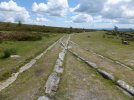blueberry11
Member
My understanding is that currently, all railways in the UK use standard gauge (4 ft 8,5 in / 1435 mm) except for Northern Ireland which (along with the Republic or Ireland) uses 5 ft 3 in 1600 mm and the Glasgow Metro which uses 4 ft / 1219 mm, as well as some of the private ones such as the one at Bure Valley Railway (near todays Hoveton and Wroxham railway station) using narrow gauge.
Back in the day, Brunel wanted the Great Western Railway (not to be confused with todays version of the same name) to use 7 ft (2100 mm) track gauge, later revised to 7 ft 1/4 inch. That is over a foot (~305 mm) wider than the next largest gauge, which is used in Spain, Portugal and India (1668/1676 mm). This is why you may be able to see wider than normal bridges and tunnels on todays GWR route.
So other than the ones I explained earlier, what track gauges have been used on UK railways?
--- edit 2024-01-04 15:00 UTC
For clarity UK includes Northern Ireland but not Isle of Wight meaning that you can post if it has used a gauge other than standard or 5 ft 3 in.
Additionally, tramways that have existed using a gauge other than 4 ft 8.5 in is also allowed (all UK tramways currently in operation use that gauge)
Back in the day, Brunel wanted the Great Western Railway (not to be confused with todays version of the same name) to use 7 ft (2100 mm) track gauge, later revised to 7 ft 1/4 inch. That is over a foot (~305 mm) wider than the next largest gauge, which is used in Spain, Portugal and India (1668/1676 mm). This is why you may be able to see wider than normal bridges and tunnels on todays GWR route.
So other than the ones I explained earlier, what track gauges have been used on UK railways?
--- edit 2024-01-04 15:00 UTC
For clarity UK includes Northern Ireland but not Isle of Wight meaning that you can post if it has used a gauge other than standard or 5 ft 3 in.
Additionally, tramways that have existed using a gauge other than 4 ft 8.5 in is also allowed (all UK tramways currently in operation use that gauge)
Last edited:



